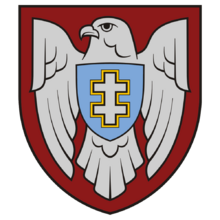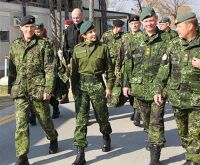Cacertian Special Reconnaissance Service
This article is incomplete because it is pending further input from participants, or it is a work-in-progress by one author. Please comment on this article's talk page to share your input, comments and questions. Note: To contribute to this article, you may need to seek help from the author(s) of this page. |
| Servizio di Ricognizione Speciale | |
|---|---|
 Official SRS insiginia. | |
| Active | 1927 - Present |
| Country | |
| Branch | |
| Type | Special Forces |
| Role | Special Operations Direct Action Special Reconnaissance Unconventional Warfare |
| Size | 9,000 (Three regiments) |
| Garrison/HQ | RHQ: Leucarum, Venetio, Cacerta 01 SRS: Molfetta, Venetio, Cacerta 02 SRS: Sassari, Sarissita, Cacerta 03 SRS: Andria, Andria Protectorate |
| Motto(s) | La notte ci protegge. (“The night protects us.”) |
| Colors | Cacertian Maroon |
| Engagements | Siduri War FedCom Civil War Nalayan Civil War |
| Commanders | |
| Current commander | Division General Marina Fiorensi |
The Special Reconnaissance Service (Italian: Servizio di Ricognizione Speciale) is a special forces unit of the Cacertian Royal Army that was established in July 1927. At the start of the Siduri War, the SRS was one of the first Cacertian units deployed to Quenmin and Tennai in order to conduct deep reconnaissance in preparation for the eventual arrival of the Royal Army. Originally tasked as a long-range and independent reconnaissance unit, its experiences in the Siduri War later lead to the expansion of its directive to include unconventional warfare and direct action.
In the modern era, members of the SRS are trained in various languages and cultures with an emphasis on working with foreign troops to complete their missions. Other responsibilities include combat search and rescue, hostage rescue, information operations, peacekeeping, and psychological operations. Much of the SRS’s operational techniques are highly classified.
As a special operations unit, the SRS often does not directly report to the authority of theater commanders and instead often directly reports to Cacerta’s High Command. However, there have been several cases of ground force commanders being given operational command of detachments of the SRS.
Mission
The primary mission of the Special Reconnaissance Service is to serve as a forward reconnaissance task force that, if necessary, can lead a force trained in unconventional warfare or serve as a clandestine guerrilla force on its own. SRS personnel are qualified in advanced military tactics as well as the regional languages and cultures in their areas of operation. They often work very closely with a host nation and perform direct action raids, peace operations, and strategic missions alongside local military forces.
Initial training for the SRS focuses heavily on the capabilities of an individual soldier with specific emphasis on clandestine operations and long-term survival. As SRS units are often deployed in small teams, it is expected for each individual to be able to survive long enough to return to friendly territory in the event they are separated from their fellow teammates. Many of the SRS’s operational fireteams are assigned prior to their graduation from training; they are expected to work closely with one another under isolated circumstances for long periods of team. As a result, many develop long-standing personal ties that often last a lifetime.
History
Origins
Siduri War
FedCom Civil War
Nalayan Civil War
Organization
The Special Reconnaissance Service is listed under the Royal Army Special Operations Command but reports directly to High Command. Very little publicly verifiable information exists on the contemporary SRS as their activities are highly classified. The SRS comprises three full regiments of active personnel; the 01 SRS, 02 SRS, and 03 SRS. Each regiment possesses its own operational bases throughout Cacertian territory with the overall regimental headquarters located at Leucarum, Venetio. The current commanding officer of the SRS is Division General Marina Fiorensi who has held the position since 2011.
Although each regiment numbers approximately 3,000 personnel each, it is believed that only one-third of each regiment is assigned to conduct direct action missions. The remaining two-thirds are made up of highly specialized personnel recruited to assist in the execution of an SRS directive.
Special Response Units
Special Responses Units, often abbreviated to SRUs, is the official name of the Special Reconnaissance Service counter-terrorism teams. They received special training in close quarters combat, sniper techniques, as well as hostage rescue within buildings and public transportation. The idea of the Special Response Units were the brainchild of Prime Minister Asella Cottone who requested Cacertian High Command to prepare a highly-trianed multi-purpose group during a time period in which terrorist and revolutionary activity began to grow exponentially throughout the region; the first SRUs were formed in early 1970s.
Members of the Special Response Units refresh their training annually and share counter-terrorist responsibility over six-month rotations. SRUs train at the Hydrantum MOUT Training Facility that includes a complex of CQC houses as well as a retired RCAC Tuva TA-86. On call Special Response Units are immediately moved the SRS’s regimental headquarters at Leucarum to which they are restricted until returning off-call.
Recruitment, Selection, and Training
The Special Reconnaissance Service has never directly recruited from the general public, only currently active members of the Cacertian Armed Forces can apply for special forces selection. SRS selections occur twice a year, regardless of weather conditions, during the summer and winter at Anzio. Personnel are limited to a maximum of two attempts with any failing candidate returned to their units. It is reported that SRS selections are one of the most demanding military training courses in the world taking approximately seven to eight months to complete and with a pass rate of less than 10%.
Special Forces Briefing Course (1 Week)
The SRS SFBC is designed to give personnel interested in volunteering for special service a clearer understanding of what is involved, what is expected of those that make it past the selection process, and how to properly prepare for SRS Selection. The course is held at Leucarum and Andria eight times a year. The SFBC is not a method to gauge pre-selection nor is any potential candidate obligated to attend, however it is highly encouraged. Those interested in the SFBC are expected to attend a course between six and nine months prior to Selection. Over the week, candidates are briefed in detail on SRS employment, undertake a map and compass test, a swimming test, a first aid test, as well as a combat fitness test. Candidates in attendance are notified of their likelihood of passing and provided with a training programme to prepare for Selection.
Aptitude Phase (4 Weeks)
The first major phase of SRS Selections is the Aptitude Phase which takes place at the Anzio Training Camp in Sarissita. Much of the four weeks is spent on the northern edge of the Rhaetian Mountains which is often characterized for its extreme and unpredictable weather conditions. It is designed to select individuals who are suitable for special forces training. This phase focuses on increasingly difficult physical training in order to gauge individual physical endurance and navigational skill.
Candidates must complete a basic infantry fitness test on the first day. The next four days focuses on an a number of physical and environmental endurance tests as initial preparation for Exercise White Peak, taking place at the end of the first week. The Exercise is a 30 kilometer load bearing march that is utilized as the first major indicator of whether or not a candidate has the physical and mental capabilities to complete the selection course. For those that complete White Peak, all other training exercises are aimed at preparing candidates for the final week of testing.
Test Week consists of five timed marches between 25 and 30 kilometers conducted on consecutive days leading up to a final endurance march of 68 kilometers. The initial marches consist of two along the Anzio Sea Cliffs of the northern coast and three in the Rhaetian Mountains. The final march must be completed within a single day; all candidates carry 30 kilograms of weight in addition to water, food, and a rifle.
Savannah and SOP Training (9 Weeks)
Candidates that pass the Aptitude Phase go on to participate in an intensive training period in Knichus at the Mariconda Training Facility. The majority of this phase is spent in the Knichan savannah in which participants are assessed and instructed in special forces tactics, techniques, weaponry, and standard operating procedures. Volunteers are put under physical and mental pressure before undergoing a series of high stress situations. Evaluators use this phase to discover an individual’s strongest qualities.
The historical decision to establish a training facility in Knichus traces back to SRS service during the FedCom Civil War and is often considered part of the unit’s tradition. At the time of Cacerta’s intervention, the savannah had only been encountered during the time period of the Cacertian Empire and the initial waves of Royal Army peacekeepers struggled in the environment. SRS personnel are often credited with assisting the Army in proper preparations and training of personnel arriving from Cacerta as the Kingdom began to commit more forces to the conflict.
Specialist Training (14 Weeks)
SERE Training (4 Weeks)
Uniforms and Equipment
Since its implementation in 1982, the primary camouflage used by the SRS when performing combat operations alongside the Royal Army has been the M1982 Foresta camouflage, although other camouflage patterns have been observed in use. When not wearing helmets, SRS personnel can be easily identified by their green berets. Despite having a formally issued uniform, SRS personnel are usually granted an enormous amount of autonomy during most military operations in which they are deployed independently. Members are rarely seen wearing a uniform outside of working with other branches of the armed forces, often wearing civilian clothing. Civilian hairstyles are also allowed to help personnel avoid recognition as members of a military branch.
The Special Reconnaissance Service is also afforded significant freedom in regards to each individual’s kit and equipment. While there is a standardized kit when operating in uniformed operations alongside other branches of the Cacertian Armed Forces, during SRS only operations each member is allowed to carry and utilized whatever they have at their disposal. When in uniform, the standard infantry weapon of the SRS is the M1982 assault rifle with the P57 handgun serving as the standard secondary.

